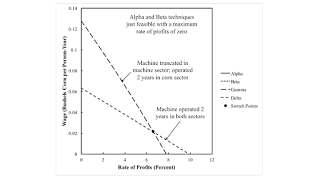Figure 1: Factor Wage Curves For Feasible Techniques There are 12 coefficients that can be varied in my minimum multisector model in which production in all sectors can require both fixed and circulating capital. I do not think I am being very orderly in exploring this twelve-dimensional space. This is a fluke case in which the maximum rate of profits is zero for both the Alpha and the Beta techniques. If only new machines are used as means of production in producing new machines and in producing corn, no surplus product is available to pay out as wages and profits. Likewise, if a machine is run for its full physical lifetime of two years in the machine sector, but truncated in the corn sector, no surplus product is, once again, available. But this is a feasible technology in that a
Topics:
Robert Vienneau considers the following as important: Example in Mathematical Economics, Joint Production
This could be interesting, too:
Robert Vienneau writes Austrian Capital Theory And Triple-Switching In The Corn-Tractor Model
Robert Vienneau writes Double Fluke Cases For Triple-Switching In The Corn-Tractor Model
Robert Vienneau writes The Emergence of Triple Switching and the Rarity of Reswitching Explained
Robert Vienneau writes Recap For A Triple -Switching Example
| Figure 1: Factor Wage Curves For Feasible Techniques |
There are 12 coefficients that can be varied in my minimum multisector model in which production in all sectors can require both fixed and circulating capital. I do not think I am being very orderly in exploring this twelve-dimensional space.
This is a fluke case in which the maximum rate of profits is zero for both the Alpha and the Beta techniques. If only new machines are used as means of production in producing new machines and in producing corn, no surplus product is available to pay out as wages and profits. Likewise, if a machine is run for its full physical lifetime of two years in the machine sector, but truncated in the corn sector, no surplus product is, once again, available. But this is a feasible technology in that a surplus product is available when machines are operated for a full two years in the corn sector. (If a1, 1 and a1, 2 are slightly increased, the maximum rate of profits is negative for both the Alpha and Gamma techniques. Then this would be a non-fluke case.)
Managers of firms choose among feasible techniques by deciding whether or not to operate machines for two years, or to truncate their use, in the machine sector. As shown by the wage frontier above, their decision varies with the distribution of income. Baldone (1980) notes the possibility that for a viable technology with fixed capital, the truncation of the economic life of a machine may result in a non-viable technology. In an already long paper, he does not have a numerical example, however. By the way, Baldone has an appendix with a numerical example of the recurrence of truncation.
For completeness, Table 1 specifies the coefficients of production. I also define the techniques, which
are unchanged from previous posts exploring this model. I would be impressed if somewhere in this
twelve-dimensional space, almost all phenomena
noted
in the literature for models of fixed capital
and new cases
could be found. I have yet to locate
cases of
reswitching
in this model.
By definition, I will not be able to find
a
| Input | Process | |||
| (I) | (II) | (III) | (IV) | |
| Labor | 1/10 | 8 | 43/40 | 1 |
| Corn | 0.875 | 2.1875 | 0.125 | 0.282386 |
| New Machines | 1 | 0 | 1 | 0 |
| Old Machines A | 0 | 1 | 0 | 0 |
| Old Machines B | 0 | 0 | 0 | 1 |
| Outputs | ||||
| Corn | 0 | 0 | 1 | 0.56 |
| New Machines | 2 | 5/2 | 0 | 0 |
| Old Machines A | 1 | 0 | 0 | 0 |
| Old Machines B | 0 | 0 | 1 | 0 |
| Technique | Processes |
| Alpha | I, III |
| Beta | I, II, III |
| Gamma | I, III, IV |
| Delta | I, II, III, IV |
- Salvatore Baldone (1980) Fixed capital in Sraffa's theoretical scheme. Trans. in Pasinetti (1980).
- Christian Bidard (2020) The wage-minimisation property. Working paper 2020-17.
- Luigi L. Pasinetti, ed. (1980) Essays on the Theory of Joint Production. New York: Columbia University Press.
- Bertram Schefold (1980) Fixed capital as a joint proudct and the analysis of accumulation with different forms of technical progress. Trans. in Pasinetti (1980).
- Paolo Varri (1980) Prices, rate of profit and life of machines in Sraffa's fixed capital model. Trans. in Pasinetti (1980).
 Heterodox
Heterodox

